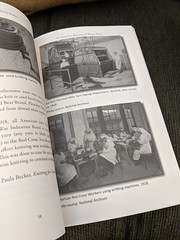First, the facts:
Title: The Knitting Brigades of World War I: Volunteers for Victory in America and Abroad
Author: Holly Korda
Published by: Self-Published
Pages: 88
Type: History
Chapters:
The In-Depth Look:
1. The Great War: 1914-1918
2. Ramping Up for War
3. Calling All Volunteers
4. The Spirit of America
5. The Junior Red Cross
6. Central Park Knitting Bee
7. It Takes a Community
8. Tools for Home Front Knitters
9. Other Hone Front Efforts
10. An Ending–and a Beginning
You might not know this about me, but reading history is one of my favorite things. It gives me a way to connect to my past (using “my” in the broadest sense, there), and get a feel for how people used to live, what they did, how they survived, what events touched their lives.
When you combine that with knitting? Even better.
The Knitting Brigades of World War I explores how knitters mobilized 100 years ago to support their troops.
You’ve heard of this, right? The drive to “knit your bit” each day to help work toward a pair of socks or hat or sweater for shivering servicemen overseas?
Except, most of us think of WWII in the 1940s when we remember this. Really, though, this international obsession with knitting started earlier, in the 1910s when the Great War broke out.
Here are a couple statistics for you:
“More than 15 million pounds of wool were worked into garments and bandages by voluneers of ‘The Great Mother,’ as the Red Cross came to be known. When women knit, they knit necessities: 24 million articles for soldiers and sailors, 14 million items of hospital supplies, 6 million refugee garments, and some 300 million surgical dressings. Items included scarves, hats, socks, sweaters, and more. As the war progressed, there would be a shortage of yarn–and people would scorn anyone who might knit for themselves when needs abroad were so great.”
(Hard to think of that, isn’t it, when recreational knitting and yarn stashes are so popular?)
This isn’t a long book–just a tight 88 pages–but it’s filled with photos and details about the effort, mostly by women, but also by men and convalescing soldiers, to provide troops around the world with the basic necessities.
Nothing makes me happier than shining light on a historical event that is in danger of being forgotten. Thank you so much, Holly, for your detailed research!
Want to see bigger pictures? Click here.

This review copy was kindly donated by the author. Thank you!
My Gush: Knitting, reading, and history–all in one place!



